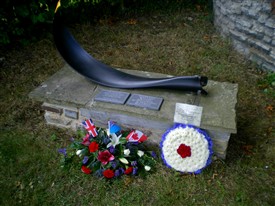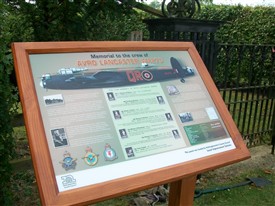The Last Crew of Lancaster W4270

The Staunton Lancaster Memorial

The Interpretation Board
The story behind a WW11 bomber crash at Staunton-in-the-Vale
By Di Ablewhite
Staunton Lancaster Crash
In November 1999, Mr Sid Baggaley, a retired farmer of Staunton, asked a family friend (Di Ablewhite) if she could do an investigation into a plane crash he witnessed in WW11, he knew she was interested in history and archaeology, but she had not undertaken any research of this nature before. For obvious reasons this tragic event left a huge mark on him, and since that night he had wanted to know more about what had happened. He had heard several rumours including the fact that one of the crew was a Canadian, but knew nothing of where they flew from or any other detail being of course wartime.
Working on the information he gave her and with a piece of the wreckage he later recovered from the crash site, she and eventually along with an ex RAF friend she met through the Nanton Lancaster Aviation groups message board in Canada (Ian Hinks) and Sid’s Granddaughter (Annie Hogg) set about finding the details of the accident. Sid really wanted to know who these men were and to hopefully see what they looked like.
Luckily the piece of wreckage he saved was a structural piece and once cleaned up by Newark Air Museum had RAF Section/Reference marks on it, which identified the aircraft as a Mark 1 Lancaster. By searching through W R Chorleys’ Bomber Command Losses books a list was made of all local Lancaster crashes.
Eventually the search narrowed down to it being just one aircraft.
On the 18th of February 1943, a crew from 61 squadron, RAF Syerston had been on a long cross country training flight when, at 22.56 hours, after 6 hrs 45 mins of flying, a con rod broke on the inner starboard engine, causing a fire, which , despite their best efforts, they failed to put out. A combination of this and the fact the landing gear was in a lowered position, caused them to lose control and the aircraft crashed.
All 7 crew members were killed and at 23 years of age the pilot, a Canadian from Saskatchewan, WO11 Thomas Herbert Warne was the oldest and most experienced member of the crew despite only having 15 hours of night flying experience on this type of aircraft.
All the men except the Canadian Pilot were buried in their respective home towns, while he is buried in Newark War Cemetery.
The crew were
WO11 Thomas H Warne R/102085 RCAF Pilot ‘Herb’
Buried in NEWARK WAR CEMETERY
Sgt George A Hitchon 576765 Flt. Eng. ‘Arthur’
Buried in PADIHAM (ST. LEONARD) CHURCHYARD EXTENSION
Sgt Robert J Preece 1174086 Obs. ‘Jack’
Buried in WEMBDON (ST. GEORGE) CHURCHYARD
Sgt Thomas R Newton 1119116 Wop/AG
Buried in BRANDON AND BYSHOTTLES (USHAW MOOR) CEMETERY
Sgt James M Whitehead 975551 Wop/AG
Buried in CAMBUSNETHAN CEMETERY
Sgt Edward J Loverock 95015 AG ‘Eddie’
Buried in MATLOCK (ST. GILES) CHURCHYARD
Sgt John Coaker 127678 AG
Buried in LEUSDON (ST. JOHN THE BAPTIST) CHURCHYARD
Sid lived long enough to know the names of the crew and where they were from, but sadly didn’t get to see any of the photos, it was 8 years later that any of those surfaced. Eventually due to endless appeals for information in the local press and on the internet, several family members came forward with amazing photos and other documents relating to the crew, and because of this the personal side of this tragedy became more apparent, and the research team were more motivated to complete as much as they could to preserve these men in history. Over 55,000 died in Bomber Command alone in WW11, not all can possibly be remembered in such detail, but it is so important as many as can be are paid tribute to.
A Memorial to this crew was built in the new burial ground of Staunton Church for the millennium exhibition. The stone was kindly donated by Mr and Mrs E. Staunton, a Lancaster propeller blade from a crash site in Crowland, was donated by LARG (Lincolnshire Aircraft Recovery Group) organised for us by Ian Blackmore, the actual memorial plinth was built by Lee Brigham and memorial plaques again bought with donations raised by Di Ablewhite auctioning off her Bomber Command Loss books. The position of the Memorial overlooks the crash site, but after 11 years parts of the memorial needed replacing and so a service was organised by Sid's Grand Daughter Annie Hogg to re-commemorate the new plaques and the restored memorial, a short film was made that can be viewed here www.vimeo.com/14431980
Since then an interpretation board has been put up by N.C.C to give visitors to the Memorial information regarding this incident, and as part of the Nottinghamshire Historical Aviation Trail (see Staunton's entry below) hundreds of people visit every year.
Staunton in the Vale
Grid Ref: Sheet 130; SK805435.
Access: Staunton in the Vale is located just off the Newark to Kilvington road. When visiting this memorial in the village church yard you should park on the public road leading down to the church / Staunton Hall, which is opposite to the Staunton Arms public house. If parking on the road side please avoid the grass verges and do not block property access driveways; the memorial can be accessed by walking approximately 250 metres down the Church Walk public foot path. Please do not try to access this site via Staunton Hall entrance.
Nationalities: British & Canadian
Background:
This memorial commemorates the crew of 61 Squadron Lancaster W4270 that crashed 1 mile north west of St Marys Church on 18th February 1943. The aircraft was operating from RAF Syerston and was returning there when it got into difficulties.
All of the crewmembers were killed in the crash and most were returned for burial in their home towns. However the Canadian pilot “Herb” Warne is buried in Newark Cemetery (No 307 Section P). A research team has investigated the nearby crash site and have found a lot of new information, including the fact that the crew trained with 1661 HCU at RAF Winthorpe.
The memorial was rededicated on 3rd July 2010 when new plaques were unveiled, and at the same time contact was made with the last of the crew mans relatives, so all are now aware of the memorial.
Please be aware that some memorials are located on private land and have been included in this guide thanks to the kind cooperation of the landowners. Please respect their property and follow the access instructions that have been carefully prepared for this guide.